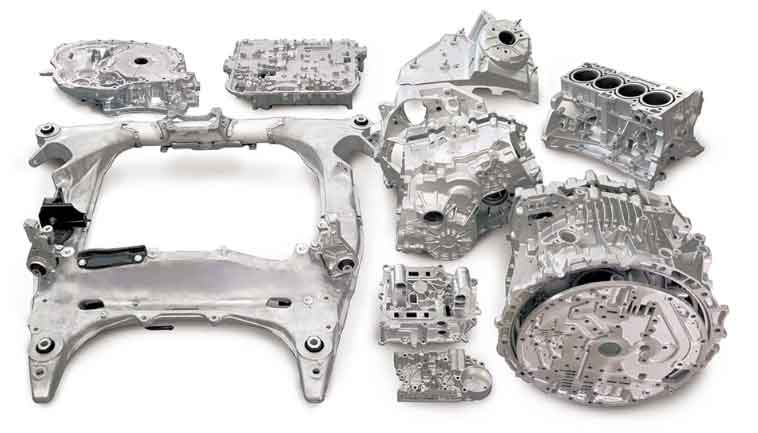The lightweight design of automotive components critically supports overall vehicle weight reduction, enhances product quality, and drives cost efficiency. This study focuses on the innovative structural optimization of a subframe for a new energy vehicle, leveraging die casting technology. The traditional welded assembly is replaced by a single-piece die-casting approach, aiming for structural performance gains and significant mass and cost reduction. Performance targets (stiffness, strength, modal, dynamic stiffness) extracted from the benchmark welded subframe guide the optimization process.

Structural optimization employs Multi-Model Optimization (MMO) technology, synthesizing topology optimization for compliance minimization (representing stiffness/strength/modal) and mass minimization (for dynamic stiffness targets). The mathematical formulation integrates these objectives and constraints:
$$
\begin{align*}
&\min W(\mathbf{x}) = \sum_{e=1}^{N} w_e(\mathbf{x}) \quad \text{(Compliance Minimization)} \\
&\min M(\mathbf{x}) = \sum_{e=1}^{N} \rho_e v_e x_e \quad \text{(Mass Minimization)} \\
&\text{subject to:} \\
&V(\mathbf{x}) = \sum_{e=1}^{N} v_e x_e \leq V_{\text{max}} \quad \text{(Volume Fraction)} \\
&\sigma_{\max}(\mathbf{x}) \leq \sigma_{\text{allow}} \quad \text{(Strength Constraint)} \\
&\text{IPI}_j(\mathbf{x}) \leq \text{IPI}_{j,\text{target}} \quad \text{(Dynamic Stiffness Constraint)} \\
&x_{\min} \leq x_e \leq 1 \quad \text{(Design Variable Bounds)}
\end{align*}
$$
Where \( \mathbf{x} \) is the vector of design variables (pseudo-densities), \( w_e \) is the element strain energy, \( \rho_e \) is the material density, \( v_e \) is the element volume, \( V \) is the total volume, \( \sigma_{\max} \) is the maximum stress, and \( \text{IPI}_j \) is the Input Point Inertance at attachment point \( j \).
Topology optimization using the MMO approach yielded a conceptual design emphasizing efficient load paths suitable for die casting. The resulting structure features strategically oriented ribs and a consolidated form factor. This concept was interpreted and reshaped into a manufacturable die-cast geometry. Subsequent parametric optimization fine-tuned the thickness distribution of ribs and walls:
$$
\min_{\mathbf{t}} M(\mathbf{t}) \quad \text{s.t.} \quad g_j(\mathbf{t}) \leq 0 \quad (j = 1, 2, …, m)
$$
Where \( \mathbf{t} \) is the vector of thickness design variables, \( M \) is the mass, and \( g_j \) are performance constraints (strength, stiffness, modal frequency, dynamic stiffness).
The performance of the optimized die-cast subframe was rigorously validated against the original welded design across all critical metrics. Significant improvements were achieved:
| Performance Metric | Welded Subframe | Die-Cast Subframe | Improvement |
|---|---|---|---|
| 1st Order Modal Frequency (Hz) | 274.8 | 320.1 | +45.3 Hz (+16.5%) |
| Max Stress – Critical Load Case (MPa) | 318.4 | 165.2 | -153.2 MPa (+48.2% Strength Margin) |
| Weight (kg) | 12.43 | 10.40 | -2.03 kg (-16.3%) |
| Manufacturing Cost per Unit (CNY) | 481.67 | 440.05 | -41.62 CNY (-8.6%) |
Key stiffness values at critical attachment points also showed substantial gains. For example:
- Steering Rack X-Stiffness: Increased from 90,909 N/mm to 142,857 N/mm.
- Arm 1 Z-Stiffness: Increased from 611 N/mm to 2,857 N/mm.
Dynamic stiffness (IPI) at suspension arm and motor mount points exhibited significant improvements, notably at Arm 2 X-direction, increasing from 282,524 N/mm to over 1,200,000 N/mm.
The transition to die casting facilitated a major structural redesign. The single-piece die-cast construction eliminates numerous welds inherent in the welded assembly. This consolidation drastically reduces part count, simplifies assembly logistics, and enhances structural integrity by removing potential weld failure points. The die casting process allows for complex geometries, integrating features like bosses and reinforced ribs directly into the casting, which were previously separate components or required secondary operations in the welded design. This integration is crucial for achieving the mass reduction and performance improvements.
Beyond the core structural benefits, the die-cast subframe offers substantial production advantages. Eliminating welding fixtures and processes reduces cycle time and labor costs. The inherent consistency of the die casting process improves dimensional accuracy and reduces part-to-part variation compared to welded assemblies. Furthermore, the die-cast subframe provides a more stable platform for attaching other chassis components, potentially improving overall vehicle assembly quality and NVH characteristics. The use of high-integrity aluminum alloys suitable for die casting ensures excellent corrosion resistance.
| Item | Welded Subframe | Die-Cast Subframe |
|---|---|---|
| Main Frame Assembly | 456.53 CNY | 436.80 CNY |
| Fasteners / Inserts | 25.14 CNY | 3.25 CNY |
| Total Cost | 481.67 CNY | 440.05 CNY |
| Total Mass | 12.43 kg | 10.40 kg |
This study demonstrates the efficacy of combining structural optimization techniques (topology and parametric optimization) with advanced die casting manufacturing for subframe development. The optimized die-cast subframe achieves a remarkable balance: significant weight reduction (16.3%), substantial cost savings (8.6%), and simultaneous improvements in all key performance metrics including structural strength (+48.2% margin), modal frequency (+16.5%), static stiffness, and dynamic stiffness. The success underscores die casting as an enabling technology for producing complex, high-performance, lightweight structural components in the automotive industry, directly contributing to vehicle efficiency and sustainability goals. The die casting process was fundamental to realizing the geometrically complex, highly integrated optimal structure identified by the MMO framework.
